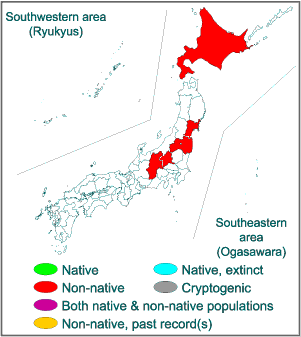
 Japanese |
English
Japanese |
English- Invasive Species of Japan >
- Mammals >
- Neovison vison
| Invasion information | ||
| Range in Japan | Entire part of Hokkaido, and several parts of Miyagi, Fukushima, Gumma, and Nagano Prefs. |

|
| Origin | USA | |
| Date | Imported four minks in 1928. Feral population was established in middle 1960s. | |
| Route | Deliberate: Imported for fur. | |
| Impact | Potentially: Predation, competition against native species. Actually: Predation on farm animals. Parasite (One of final host for Metacercariae Euryhelmis constaricensi, recently emerging as a threat to an endemic salamander Hynobius lichenatus). Native organism(s) affected: Native weasels (competition), Tohoku salamander Hynobius lichenatus (parasite), native small animals and farm animals (chickens, fishes, etc.) (predation) | |
| Regulation in Japan | Import, transport and keeping are legally restricted in Japan. | |
| Introduced range in other countries | China, Europe (Belarus, Belgium, Czech, Denmark, Estonia, Latvia, Lithuania, Netherlands, Norway, Poland, Portugal, Russia, Spain, Sweden, Finland, France, Germany, UK, Iceland, Ireland, Italy), etc. | |
| Reference | Notes |
|